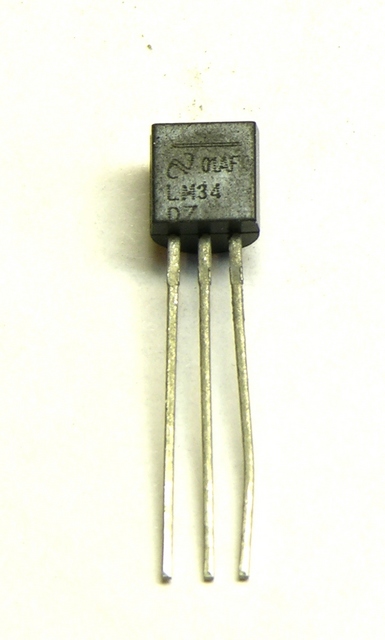This started as notes I made to myself long ago for the LogoChip, but they apply equally to the Arduino A/D converters.
The LM34DZ is a temperature sensor in a TO-92 case available from All Electronics for $2.50. It has the handy characteristic of reading an output voltage that directly corresponds to Fahrenheit temperature in a ratio of 10mV per °F. That is, at 70°F it reads 70 * 10mV = 700mV.
With a direct output voltage (rather than the varying resistance that many thermal probes provide), it’s perfect for hooking to a microcontroller A/D input. So, how to convert the A/D reading back into Fahrenheit temperature?
Well, the sensor reads 10mV (or .01V) per °F. Microcontroller A/D converters tend to have 5V input and read 1024 steps over the 0-5V range.
1024 steps / 5V ≈ 205 steps / V
So
(.01V / °F) * (205 steps / V) ≈ 2 steps / °F
Thus you can get a “maybe close enough” approximation with code like
tempF = analogRead(lm34Pin) / 2;
With a conversion error of +2.4%, this’ll get you within a couple of degrees at room temperature — close enough to make some macro-level observations about whether it’s getting warmer or colder for a physical computing project. Since the stated accuracy is only 1°F anyway, that’s not too bad.
If you need a more accurate conversion, you’ll need to use floating-point arithmetic if you have it (which the Arduino doesn’t [correction: does]) or find a fixed-point arithmetic library if you don’t. Or if your integer variables are large enough (at least 17 unsigned bits for temperatures up to 127°F, 18 bits up to 255°F), you can rearrange the order of calculation like so:
tempF = (1024 * analogRead(lm34Pin)) / 5;

I think Arduino does have floating point. I’ve used it, at any rate: http://www.arduino.cc/en/Reference/Float
A very simple improvement would be to feed the 3.3V output to the AREF pin for ~3.1 steps per degree. Slightly more involved would be to use an op amp to give you full scale for the temperature range of interest.
Jim, I don’t know why I thought there was no floating point on the Arduino — you’re clearly correct. Thanks for pointing that out.
I like the LM34DZ in part because it doesn’t require external components for preamplification or level-shifting. But I really dig your idea of feeding a different voltage to AREF — thanks!
There are quite a few temperature sensor ICs in the LM family. In addition to the analog ones, there are some which are digital (e.g., National LM75/Maxim DS75). These have an I2C bus, which means that you can
put several of them on the same I2C bus (e.g., Sprinkle them around a card, enclosure, etc.).
Dave
Dave, the I2C chips sound interesting, especially in SMT. Thanks for pointing that out!
iam in uganda trying to design a LED thermometer requiring an LM34DZ temperature sensor IC but i have failed to get it. i would like alternative ICs of LM32DZ
am in uganda trying to design a LED thermometer requiring an LM34DZ temperature sensor IC but i have failed to get it. i would like alternative ICs of LM34DZ.
i will greatful for your response
There’s another way to scale an a/d reading that doesn’t involve floating point math, but does require 16 bit variables.
Lets say your a/d reading is a value of 150, which is about .732 volts / 73 degrees
using a simple function such as this will allow you to scale a adc count to any value (with some limitations – see the last paragraph).
By adjusting the value of fs up or down, you can fine tune the output. fs is the value for 1024 counts.
uint16_t scale_adc(uint16_t adc, uint16_t fs) { uint16_t v=adc<>=1; // divide v by 2 if (fs&0x8000) { // see if fs bit 15 is set result+=v; // if so, update result } fs<<=1; // multiply fs by 2 } return result; } // a test program int main(void) { uint16_t adc,fs,temp1; adc=150; for (fs=5000; fs<=5010; fs++) { temp1=scale_adc(adc, fs); printf("fs=%d, adc=%d, scale_adc=%d\n", fs, adc, temp1); } return 0; }running this gives:
So a value of around 5010 would be optimum for 73.2 degrees.
Going a little further, fixing fs at 5010 and varying the adc count:
This method isn’t perfect, but it doesn’t require floating point math.
Try to stay away from fs values that are a power of 2 (128,256,512,1024,etc).
i am just a beginner in electronics and i want to know the pin configuration for the LM32DZ.. thanks!
Phew, if you follow the link to All Electronics, you can download the datasheet from them. It shows the pinout that you’re looking for.